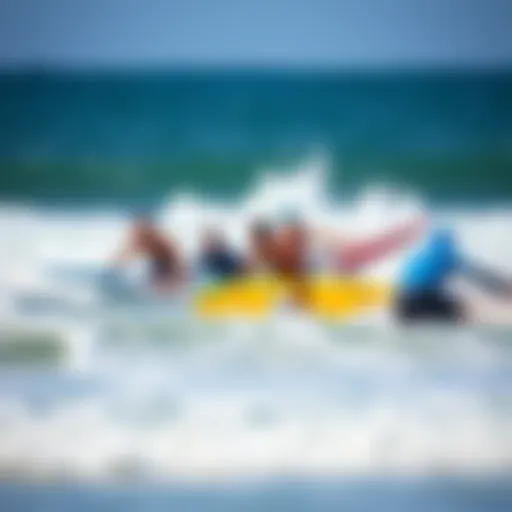Essential Gear and Considerations for Paddle Boarding
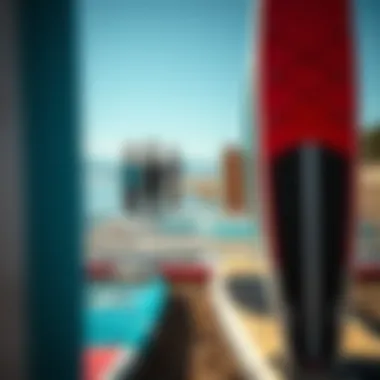
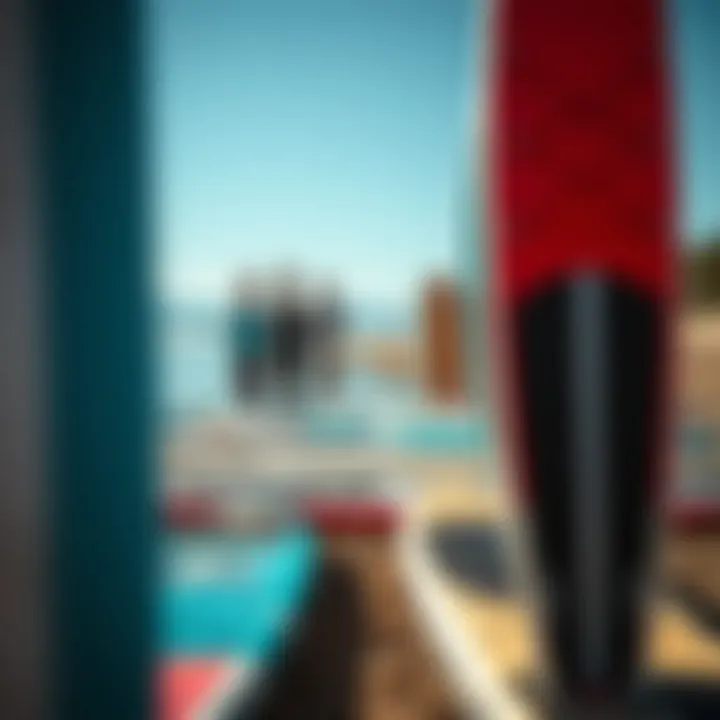
Intro
Paddle boarding has become a popular choice for water enthusiasts who want to soak up the sun while getting a good workout. The combination of leisure and fitness, all while gliding across tranquil waters, has lured many to try their hand at this engaging sport. However, before you joyfully jump on a paddle board, it's crucial to have a firm grasp on the essential gear, safety considerations, and maintenance tips that come hand-in-hand with the sport.
Understanding the nuances of paddle boarding is not just about having a good time; it’s about ensuring a safe and enjoyable experience. Whether you are a seasoned paddler or a novice looking to dip your toes into this vibrant world, knowing what equipment to invest in and the best practices to follow can make all the difference.
This section will lay the groundwork for your paddle boarding journey, making it easier to navigate through the various choices and considerations you’ll face along the way. From selecting the right board to understanding safety gear and environmental aspects, each part plays a role in crafting your paddle boarding experience. Let's dive in and explore the ins and outs of paddle boarding equipment and essential safety measures.
Understanding Paddle Boarding
Grasping the concept of paddle boarding is fundamental for anyone interested in exploring this popular water sport. It’s not just about standing on a board and paddling; understanding paddle boarding encompasses the techniques, varying styles, and the underlying joy it brings. Paddle boarding offers numerous benefits, especially for mental well-being, physical fitness, and connection with nature. It encourages individuals to engage with their surroundings while being active.
When you dive into paddle boarding, you're not just participating in a sport, you're becoming part of a global community that values fitness, adventure, and conservation. Recognizing diverse styles can help in honing your skills or selecting a paddle board that fits your specific purpose, whether that’s relaxation, racing, or more tranquil activities like yoga.
The Origin of Paddle Boarding
Paddle boarding traces its roots to ancient Polynesian culture, where it was utilized by Hawaiian fishermen. They would glide on solid wood boards with a paddle to catch fish or navigate between islands. Over time, this method evolved into the modern recreational activity we know today. It gained popularity in the late 1940s when surf instructors began using paddle boards to teach surfing techniques.
This fusion of functionality and leisure has now led to paddle boarding being a staple in water sports, appealing to enthusiasts worldwide.
Different Types of Paddle Boarding
The broad spectrum of paddle boarding styles speaks to its versatility and widespread appeal.
Recreational Paddle Boarding
Recreational paddle boarding is perhaps the most accessible form for beginners. It invites a leisurely exploration of lakes, rivers, or oceans, where the primary goal is to unwind and enjoy the scenery. With its broad boards, this type is stable and focuses on comfort and ease of use. Many newcomers find this style appealing due to its low barrier to entry and potential for casual and social outings. The gentle pace allows paddlers to appreciate nature fully, fostering a relaxing experience.
One notable feature of recreational paddle boards is their design, which often comprises a wider stance to ensure balance. However, they may lack the speed efficiency found in more specialized boards. It's best suited for those aiming to paddle primarily for leisure and enjoyment.
Racing Paddle Boarding
For those seeking an adrenaline kick, racing paddle boarding offers a competitive edge. Designed for speed, these boards are generally longer and narrower, allowing for improved glide and efficiency. This category rapidly gained traction with organized races and competitions sprouting up globally.
The key characteristic of racing paddle boards is their streamlined design, which minimizes water resistance. They tend to be less stable than recreational boards, requiring greater skill and experience to handle effectively. Racers benefit from enhanced performance but may find the learning curve a bit steep. Typically, this type of paddle boarding is popular among those looking for intense workouts or wishing to compete.
Yoga Paddle Boarding
Yoga paddle boarding, or SUP yoga, takes the tranquil practice of yoga onto the water. This style has surged in popularity owing to its unique combination of fitness and meditative serenity. On a stable paddle board, practitioners enjoy the benefits of yoga while surrounded by beautiful natural landscapes.
The notable feature of yoga paddle boards is their stability. They tend to be wider to accommodate various yoga poses and movements. This type is increasingly sought after by fitness enthusiasts who appreciate both yoga's calming effects and the invigorating experience of being on the water.
Though rewarding, the practice can pose challenges, especially for those new to yoga or SUP. Balancing mental focus while dealing with shifting water conditions can be tricky, but many find that the rewards outweigh these challenges.
Fishing Paddle Boarding
Fishing from a paddle board combines the joys of water sports with angling. Fishing paddle boards typically come equipped with a spacious design to provide stability while casting lines and reeling in the catch. This style invites enthusiasts to explore remote fishing spots that traditional boats might overlook.
Among its benefits, fishing paddle boarding allows for a more personal and closer communion with nature. Anglers can utilize their paddling skills to navigate to their favorite hot spots. The added challenges come from balancing fishing gear on the board and managing potential waves or currents. But for dedicated anglers, the quieter, stealthier approach provides a unique advantage in catching fish more effectively.
Paddle boarding isn’t merely a sport; it’s a passport to adventure, offering diverse styles that cater to every individual's preferences and skill levels.
Choosing the Right Paddle Board
Selecting the appropriate paddle board is undeniably crucial for anyone looking to get involved in this sport. The kind of board you choose not only affects your comfort and performance but also influences how enjoyable your experience will be on the water. Understanding the different elements involved in your choice—like materials, size, and weight capacity—can enhance your capabilities and boost your confidence, whether you are just starting or you're a seasoned pro.
Materials Used in Paddle Boards
When it comes to paddle boards, materials play an important role in how well the board performs and lasts. Different types offer unique characteristics, affecting factors like durability, weight, and practicality. Let's break down two main categories: inflatable boards and rigid boards.
Inflatable vs. Rigid Boards
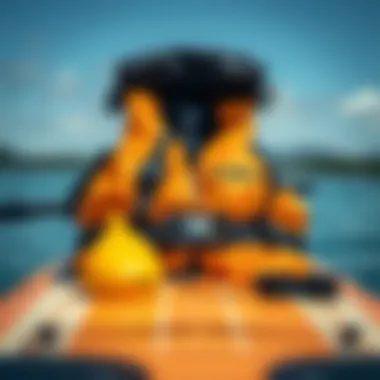
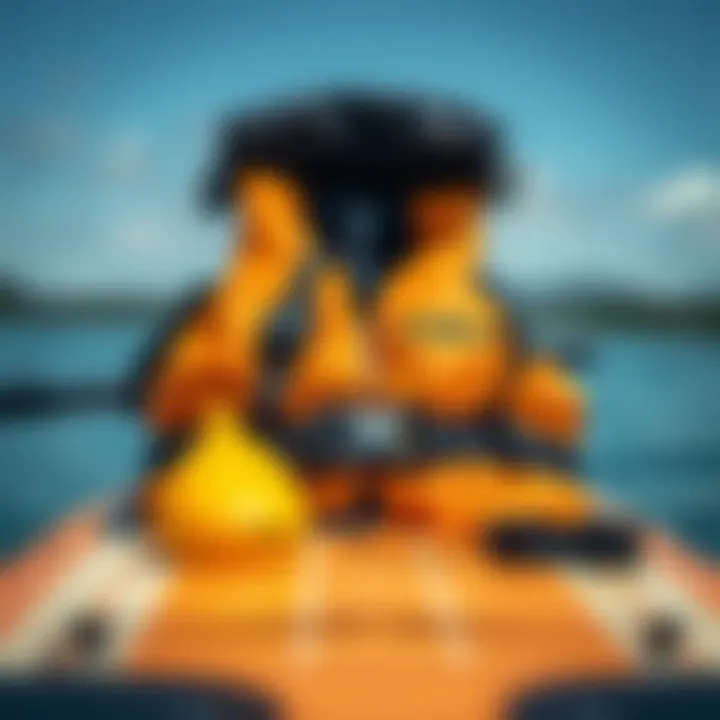
Inflatable paddle boards can be a game changer for those with limited storage space, since they can be deflated and packed away easily. The standout feature here is that once inflated, these boards reach surprisingly high rigidity, which is often beyond what many newcomers might assume. Inflatable boards are generally lighter and more portable, making them popular among travelers and casual paddlers. Despite that, they tend to be more susceptible to punctures than their rigid counterparts.
On the flip side, rigid boards, usually constructed from fiberglass or epoxy, offer unmatched stability and performance. They provide a superior glide on the water, which is particularly beneficial for racing or long-distance paddling. However, these boards are bulkier and require more storage space, and transporting them can be a hassle unless you have a large vehicle.
Ultimately, the choice between inflatable and rigid boards hinges on your personal needs and circumstances.
Construction Materials: EPS, Epoxy, and Foam
Now, let’s dive into the construction materials commonly used in both inflatable and rigid boards. A major player is EPS (expanded polystyrene), a lightweight foam that provides buoyancy. Thanks to its minimal weight, EPS boards can be molded into various shapes including those designed for specific activities, like yoga or racing. However, while EPS can provide great performance, it's often combined with other materials for enhanced durability.
Epoxy is another popular choice, widely used for rigid paddle boards. Known for its durability and strength, epoxy adds a good level of resistance to UV damage and abrasion, which is critical if you plan on paddling in tough conditions.
Foam boards are often the choice for beginners or for recreational use. They tend to be affordable, stable, and safe for learners. However, their performance might not meet the preferences of competitive paddlers. Each material comes with its own set of pros and cons, so weighing your options is key.
Sizing Your Paddle Board
Choosing the right size for your paddle board can significantly affect your paddling experience. Board dimensions, including length and width, impact stability, speed, and maneuverability. Understanding these elements can help ensure that you select a board that suits your personal paddling style.
Length and Width Considerations
Length and width are two critical factors in determining a board's overall performance. Longer boards typically glide faster and cover more distance effectively, making them ideal for those looking to race or travel long distances. On the other hand, shorter boards tend to be more maneuverable which can be advantageous in tight conditions, such as rivers or crowded waterways.
In terms of width, boards that are wider offer better stability, making them suitable for beginners or less experienced paddlers. However, a narrower board may be more fitting for someone looking to improve speed. These considerations can mean the difference between a smooth paddle and a frustrating one.
Weight Capacity Guidelines
When picking a paddle board, understanding its weight capacity is essential. Each board is designed to support a specific weight, which includes not just the paddler’s weight, but any additional gear. Boards with lower capacity can quickly become unstable, leading to a less enjoyable experience.
Most manufacturers will provide a weight guideline, and it's wise to adhere to these recommendations to ensure optimal performance. If you plan to take along gear, consider that addition when assessing your weight limits.
Essential Paddle Board Gear
Paddle boarding, while it may seem straightforward, demands a variety of essential gear to ensure safety and enhance the experience. The right equipment not only ensures a smoother ride but also provides layers of safety that are indispensable on the water. Each item in a paddler's gear collection serves a purpose, from the paddle itself to the safety equipment, allowing enthusiasts of all skill levels to navigate the waters with confidence. Here, we will delve into crucial aspects of paddle boarding gear, bringing clarity to the choices available.
Paddle Selection
Choosing the right paddle can make or break your paddle boarding experience. Quite simply, a suitable paddle aligns with your body mechanics and paddling style. If you pick poorly, it can lead to fatigue or even injury during longer excursions. Let’s break down the types of paddles.
Types of Paddles: Adjustable, Fixed, and Lightweight
A key characteristic of paddle selection lies in understanding the different types: adjustable, fixed, and lightweight paddles. Adjustable paddles are versatile; they can be modified to various lengths, making them a popular choice among those who may share their gear or who look for adjustments based on changing conditions. On the flip side, fixed paddles offer stability as they are tailored to a specific height, providing a direct connection to the water.
Lightweight variants are often made from premium materials like carbon fiber, which make them easier to maneuver but usually come at a higher price. In terms of advantages, adjustable paddles accommodate a range of users and varying conditions, while fixed paddles can enhance performance for the individual who knows their preferences.
Choosing the Right Paddle Size
Selecting the right paddle size is paramount. Height and type of paddle boarding greatly influence your choice. A longer paddle helps in achieving better strokes for taller individuals, while shorter paddles can be more manageable for those who are smaller. The unique feature of appropriate size lies in its effect on efficiency and endurance. A properly sized paddle contributes to energy conservation, allowing for longer outings without undue fatigue. The downside of choosing a paddle that’s too long or too short can lead to strain, impacting enjoyment.
Safety Equipment
No gear list would be complete without a focus on safety. Shifting boats and unexpected winds can pose challenges, making safety equipment a necessity. Key items here include Personal Floatation Devices (PFDs) and leashes.
Personal Floatation Devices (PFDs)
Personal Floatation Devices, or PFDs, are your best friend when it comes to safety on the water. They come in various styles – from the bulkier jackets to slimmer designs that offer more freedom of movement. Their primary function is to keep you afloat in an emergency. Given that weather and water conditions can change unexpectedly, wearing a PFD is a wise choice whether you're a novice or a seasoned pro. The main advantage of PFDs is that they provide buoyancy and peace of mind, which is invaluable when you're out in potentially unpredictable situations.
Leashes and Whistles
Leashes are equally important, serving to keep your board tethered to you. If you fall, your paddle board remains within reach, preventing it from drifting away.
Whistles add another layer, letting others know your position if you're in trouble or need help. These are lightweight and easy to attach to your PFD or belt loop. While leashes contribute to safety by ensuring your board stays close, they can also become a nuisance if they tangle or snag. Nonetheless, their function is critical in crowded waters.
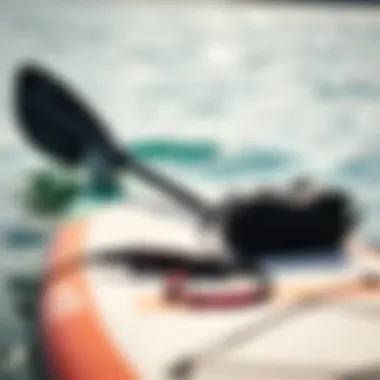
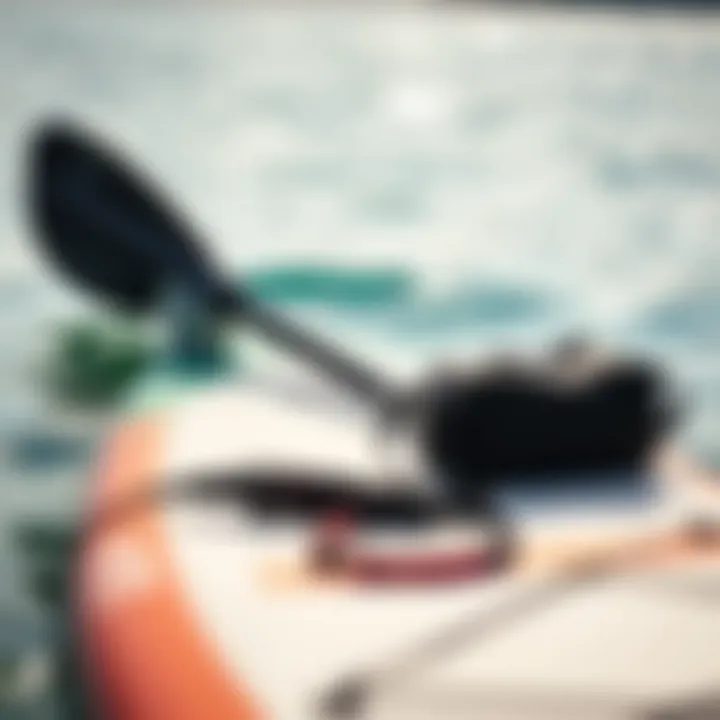
Additional Accessories
A myriad of accessories can elevate your paddle boarding outings from good to great. Let’s explore some of these necessities like dry bags, apparel, and protection tools.
Dry Bags and Storage Solutions
Keeping your belongings safe from water is where dry bags shine. They’re designed to be watertight and can shield valuable items like keys, phones, or snacks from the elements. Their versatility makes them appealing; whether you’re on a calm lake or venturing through choppy waters, having a dry bag can alleviate worries about water damage.
SUP Apparel and Footwear
SUP apparel and footwear are tailored for comfort and performance. Invest in moisture-wicking fabrics that promote breathability and support movement. Footwear, on the other hand, can provide grip on your board, particularly important when conditions are slippery or wet. While casual wear may suffice, specialized gear can enhance your overall experience.
Sun Protection and Hydration Tools
Lastly, don’t overlook the importance of sun protection and hydration. Long hours on the water expose skin to harmful UV rays, so wearing sunscreen, hats, and protective clothing is essential. Hydration tools like water bottles or hydration packs are key to keeping you fueled through your adventure; even a slight case of dehydration can turn a pleasing day on the water into a tiresome endeavor.
Understanding the essential gear for paddle boarding sets the foundation for a safe and enjoyable experience, as paddle sports thrive on reliable equipment. Selecting each piece thoughtfully ensures every trip onto the water is just as exhilarating as it is secure.
Understanding Water Conditions
Understanding water conditions is a critical aspect of paddle boarding. This knowledge not only ensures a safe journey but also enriches the overall experience on the water. Factors such as tides, currents, weather, and site-specific regulations contribute immensely to how one's paddle boarding adventure unfolds. Recognizing these elements enhances decision-making both in preparation and during the outing, thus, aligning with safety and enjoyment goals.
Assessing Water Conditions Before Paddle Boarding
Understanding Tides and Currents
Tides and currents shape the waterways, influencing what you can expect while paddle boarding. Tides are the rise and fall of sea levels caused by the gravitational forces exerted by the moon and sun. Knowing when high tide and low tide occur helps in planning your trip. High tide can create a more stable environment with gentler conditions, while low tide might expose rocks or shallows, making navigation tricky.
Currents, whether from rivers or ocean waves, hold their own challenges. Strong currents demand respect and understanding. For example, paddling against a swift current can wear you out quickly, possibly leaving you gasping for breath. Alternatively, riding with a current can make for an exhilarating ride; however, it can also lead you to areas you might not want to be. Always check local tide tables and current forecasts to inform your paddle itinerary. This awareness is beneficial as it allows a paddle boarder to anticipate not only the movement of water but also to adjust their physical exertion accordingly.
"Knowing the tides and currents is like having a compass; it points you in the right direction."
Weather Patterns and Wind Considerations
Weather plays a pivotal role in paddle boarding and can swing from serene to severe without warning. Winds can create chop on the water's surface, making navigation difficult for paddlers, especially beginners. Strong winds can make it feel like you're pushing against a brick wall if you're paddling into it. Conversely, a favorable wind can provide an enjoyable speed boost.
Understanding weather patterns includes observing clouds, wind speed, and temperature changes. Local meteorological reports can be invaluable, but a glance at the sky can tell you a lot too. For example, the presence of dark clouds can indicate storms approaching, which is a strong signal to head back to shore. A unique weather feature to consider is the phenomenon known as sea breezes – these are winds that start in the late morning as the land heats up, and they can affect coastal paddle boarding significantly.
Approaching storms or changing weather patterns are also crucial to watch out for. Getting caught in unexpected rain, thunder, or lightning can quickly change your day from fun to frightening. So, staying attuned to the elements allows for thoughtful decisions before setting out on the water.
Selecting Locations for Paddle Boarding
Selecting the right location can make or break a paddle boarding experience. Some areas offer tranquil waters perfect for beginners, while others present elements that challenge even seasoned paddlers.
Calm Waters vs. Challenging Environments
Calm waters are generally the go-to choice for novice paddle boarders. Lakes and slow-moving rivers are ideal for learning basics such as balance, steering, and paddling techniques without worrying about waves or strong currents. In these settings, paddlers can practice and build confidence at a relaxed pace.
On the other hand, challenging environments like ocean swells or rushing river rapids can lead to mesmerizing experiences for those seeking adventure. These conditions might not be suitable for beginners due to increased risks. Experienced paddlers often thrive in these challenges, employing advanced techniques to navigate the waters successfully. Therefore, knowing your skill level and choosing a location that matches is essential for both safety and enjoyment.
Restricted Areas and Regulations
When planning a paddle boarding trip, it’s imperative to be aware of any restricted areas and regulations governing the waterways. Certain spots may restrict access during certain times for wildlife preservation, safety concerns, or environmental protection. Paddling into restricted areas not only poses risks but also can result in fines.
Regulations may include specific requirements for using a personal flotation device or guidelines on the times when certain areas can be accessed. Being informed is not just about avoiding trouble; it’s about protecting the natural environments paddlers enjoy. Additionally, many locations provide resources or websites that list the current restrictions, making it easier to stay compliant with laws that change.
To sum up, understanding water conditions before embarking on a paddle boarding journey is paramount for all skill levels, and knowing how tides, currents, weather, location, and regulations interplay adds depth to the journey. Adequate preparation in these areas contributes significantly to the safety and joy characteristic of an enjoyable paddle boarding experience.
Legal Considerations for Paddle Boarders
Paddle boarding, while often viewed as a leisurely activity, carries with it a host of legal considerations that every paddler should take seriously. Knowing the local laws and regulations not only protects you but also helps to conserve the environment and maintain the integrity of public waterways. Familiarity with these legal aspects can significantly improve your paddle boarding experience by ensuring safety and compliance, which ultimately benefits everyone on the water.
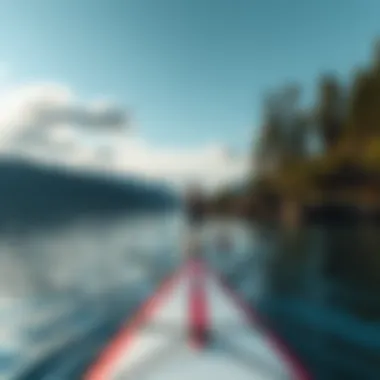
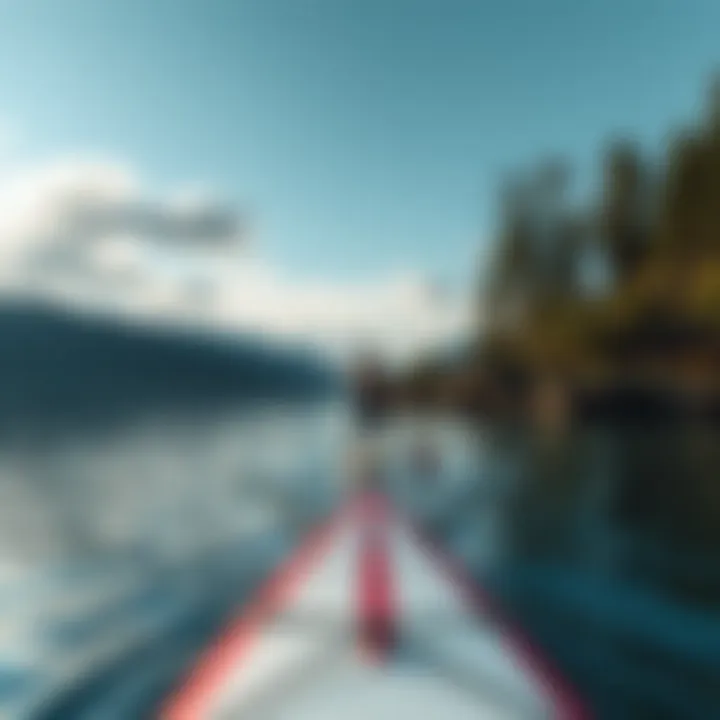
Understanding Local Laws and Regulations
Registration and Licensing Requirements
Many regions have specific registration and licensing requirements for paddle boards. This aspect is crucial for maintaining order on the waterways and ensuring that all users are accounted for in the case of emergencies. For instance, in some states, certain paddle boards might require registration if they possess a specific weight or length. It’s a beneficial choice because it typically involves a straightforward process that helps establish accountability on the water.
A unique feature of these requirements is the potential for fines if not adhered to, which can detract from an otherwise enjoyable experience. However, the advantages generally outweigh the negatives; by registering, you show a commitment to responsible paddle boarding and contribute to the awareness of safety regulations among peers.
Environmental Regulations and Protected Areas
Environmental regulations often dictate where you can paddle, especially in areas that are designated as protected. These measures are in place to preserve natural habitats and the ecosystems within them. Understanding these regulations is vital for anyone looking to explore more off-the-beaten-path locations. By staying informed and adhering to these rules, you play a direct role in conserving vital natural resources.
They often have specific guidelines which can include no-go areas, especially during breeding seasons for certain wildlife. The main characteristic of these regulations is their protective nature, ensuring that areas which are rich in biodiversity are not harmed by recreational activities. By following these guidelines, you not only show respect for the environment but also for the local communities that rely on these ecosystems for their livelihoods.
Paddle Board Etiquette
Navigating with Other Watercraft
As paddle boarders, you will find yourself sharing the waters with various vessels—from kayaks to motorboats. Understanding how to navigate around other watercraft is not just about safety; it’s also about respecting the cooperative space we all share. This is vital in avoiding accidents and ensuring smooth interactions on the water. Gaining knowledge of the rules of right-of-way can significantly enhance your experience.
For instance, paddle boarders generally have the responsibility to keep clear of larger vessels, as they can’t maneuver as quickly. This understanding helps each water user enjoy their time without the fear of collisions or misunderstandings. Navigating politely means signaling intentions and maintaining awareness, crucial skills for all paddlers.
Respecting Wildlife and Natural Habitats
Respecting wildlife while paddle boarding means being aware of your surroundings and acting accordingly. When paddling through a natural habitat, it’s important to avoid disturbing wildlife, particularly nesting birds or other sensitive species. Understanding these dynamics contributes to a harmonious coexistence with nature and promotes responsible paddle boarding practices.
The unique feature in this context is the potential impact on local ecosystems. Disregarding wildlife regulations can lead to negative consequences, both for the animals and the paddler. However, observing and respecting these habits can enhance your paddle boarding experience, offering a unique opportunity to connect with nature while ensuring it remains intact for future generations.
"A good paddler doesn’t just navigate the waters; they navigate the laws and the environment, ensuring a safe ride for all."
By investing the time to understand and adhere to these legal considerations, you are not just ensuring your own safety and compliance but are also fostering a respectful relationship with other water users and the environment.
Maintaining Your Paddle Board
Maintaining your paddle board is critical for both performance and longevity. Just like any equipment, if not taken care of, your paddle board can suffer damage that affects your experience on the water. Regular maintenance can help you avoid costly repairs and ensure that your board remains safe and functional. By paying attention to routine upkeep and understanding seasonal influences, you'll paddle with peace of mind, allowing you to focus on enjoying the waves.
Routine Maintenance Practices
Cleaning and Storage Tips
Keeping your paddle board clean is simple yet incredibly important in maintaining its surface and performance. After every session, rinsing with fresh water helps wash away salt, dirt, and any debris that might cling on. A thorough clean not only keeps your board looking sharp but also prevents corrosion or deterioration of materials.
Store your board in a cool, dry place, preferably indoors and out of direct sunlight. Prolonged exposure to UV rays can warp the shape and color of your board, leading to structural changes over time. Using a soft cloth for drying can also prevent scratching during storage.
One of the standout features of good storage practices is that it extends the life of your equipment, reducing the chances of costly replacements down the line. However, ignoring proper cleaning can lead to less-than-ideal surfaces, which can impact your performance and maneuverability on the water.
Checking for Damage and Repairs
Regularly checking for damage on your paddle board is essential for ensuring safe usage. Cracks and dents, particularly in inflatable boards, can slowly become problematic and lead to air leaks. A keen eye can spot minor issues before they escalate into something significant. Look closely at any seams and any areas where the board has made contact with structures or rocks.
What’s useful about these inspections is that they empower you to take action early, preventing major repairs later. Assessing the condition of your board lets you plan for repairs and helps maintain performance efficiency, making it easier to paddle and maneuver. Neglecting this step, however, can risk your safety on the water.
Extending the Lifespan of Your Gear
Seasonal Considerations
As the seasons change, so too does how you should care for your paddle board. Each season presents unique challenges; for example, during winter months, temperature fluctuations can potentially damage materials, whereas summer can pose threats from UV rays. In colder regions, it's advisable to store your board in a temperature-regulated environment to avoid materials becoming brittle.
By being aware of these seasonal shifts, you can apply tailored maintenance strategies that protect your equipment. Such considerations can improve not only the longevity of your board but also your enjoyment during various paddle boarding conditions. Skipping these seasonal checks can leave gear susceptible to unnecessary wear and tear.
Replacing Worn Equipment
Knowing when to replace worn gear is an indemorable aspect of maintenance. Look out for shifts in performance, as signs of excessive wear might manifest in how your board glides through the water. Key areas such as paddles, leashes, and personal floatation devices should be replaced if they show signs of damage or reduced effectiveness.
The key characteristic of timely replacements is safety. Old or worn equipment can fail at crucial moments. Staying attuned to equipment condition not only ensures your safety but enhances your overall experience on the water. If you delay replacing items, you run the risk of navigating with compromised gear that could fail unexpectedly.
In summary, maintaining your paddle board is not just about keeping it clean; it involves comprehensive knowledge and attention to detail. From seasonal practices to lifespans of gear, regular checks and targeted care can significantly enhance your paddle boarding experience and ensure safety. Remember, a well-cared-for board is one that can be navigated with confidence.



